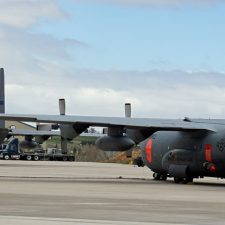Above: MAFFS 8 and 9 at annual training in Cheyenne April 30, 2014. Photo by Bill Gabbert.
The Modular Airborne FireFighting System (MAFFS) mission that has been assigned to the North Carolina Air National Guard is being transferred to the Nevada Air National Guard’s 152nd Airlift Wing. The base at Reno-Tahoe International Airport will transition to obtain the ability to supply two C-130s equipped with the slip-in 3,000-gallon retardant tanks. It will be one of the four bases that can each supply up to two C-130s as part of a surge capacity when the privately contracted air tanker fleet is overtaxed. The other three are in Cheyenne, Colorado Springs, and Ventura County California.
Below is an excerpt from an article in the Great Falls Tribune:
The North Carolina unit is converting from C-130s to C-17s and that prompted the National Guard to evaluate existing C-130 Air National Guard units for a suitable replacement for the MAFFS mission, according to the National Guard.
The Great Falls Tribune also reports that some Montana politicians were very disappointed that the MAFFS were not relocated into their state. They may be assuming that the location of the units implies suddenly greatly enhanced aerial firefighting resources. But the fact is when they are activated, which can take up to a couple of days, more often than not the aircraft are deployed to a far-away base. However, the governors with MAFFS assigned to their state Air National Guards (California, Wyoming, and now Nevada) have the authority to activate the MAFFS within their states. Other activations require a national-level approval process. The units in Colorado Springs are operated by the Air Force Reserve.
Until the crash of MAFFS 7 on July 1, 2012 there were nine of the slip-in MAFFS units (which included one spare) that can convert a C-130 to an air tanker in a few hours. Now there are eight, and one of those is being used temporarily by the U.S. Forest Service in an HC-130H acquired from the Coast Guard. The plan is to use that one unit until conventional gravity-powered retardant delivery systems are installed in at least one of the seven HC-130Hs formerly owned by the Coast Guard. But that process, first started July 29, 2014, is stalled. That means a maximum of only seven military aircraft outfitted with MAFFS units can be activated. In 2015 the North Carolina unit was the base with only one MAFFS.

Thanks and a tip of the hat go out to Bean and Dave.

